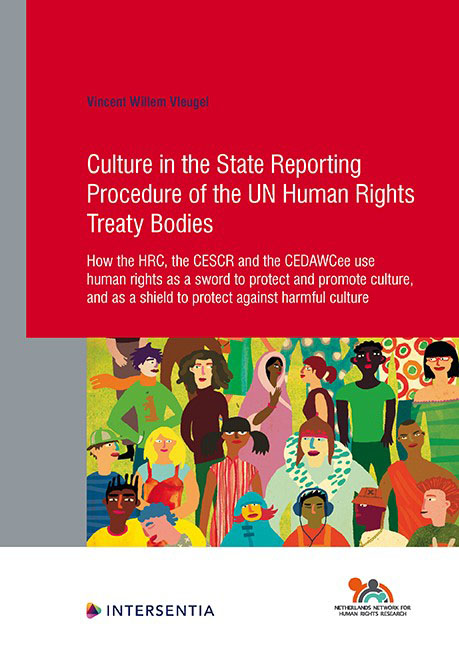 Culture in the State Reporting Procedure of the UN Human Rights Treaty Bodies
Culture in the State Reporting Procedure of the UN Human Rights Treaty Bodies Book contents
- Frontmatter
- Acknowledgements
- Contents
- Abbreviations
- Note on Citation Formats
- Note on Grammar
- Chapter 1 Introduction
- Chapter 2 Human Rights and Cultural Diversity. Between and Beyond Universalism and Cultural Relativism
- Chapter 3 UN Treaty Bodies. Treaties, Committees, Working Methods
- Chapter 4 Human Rights as a Sword. To Protect and Promote Cultural Diversity
- Chapter 5 Human Rights as a Shield. To Protect against Harmful Aspects of Culture
- Chapter 6 Cultural Argumentation. The State Reporting Procedure as a Platform for Cross-Cultural Dialogue
- Chapter 7 Conclusions. How the Treaty Bodies Universalise Human Rights
- Bibliography
- Summary
- Samenvatting
- Human Rights Research Series
Chapter 3 - UN Treaty Bodies. Treaties, Committees, Working Methods
Published online by Cambridge University Press: 11 November 2021
- Frontmatter
- Acknowledgements
- Contents
- Abbreviations
- Note on Citation Formats
- Note on Grammar
- Chapter 1 Introduction
- Chapter 2 Human Rights and Cultural Diversity. Between and Beyond Universalism and Cultural Relativism
- Chapter 3 UN Treaty Bodies. Treaties, Committees, Working Methods
- Chapter 4 Human Rights as a Sword. To Protect and Promote Cultural Diversity
- Chapter 5 Human Rights as a Shield. To Protect against Harmful Aspects of Culture
- Chapter 6 Cultural Argumentation. The State Reporting Procedure as a Platform for Cross-Cultural Dialogue
- Chapter 7 Conclusions. How the Treaty Bodies Universalise Human Rights
- Bibliography
- Summary
- Samenvatting
- Human Rights Research Series
Summary
INTRODUCTION
The aim of this chapter is to explain the monitoring procedures with which the treaty bodies can oversee implementation of the treaty provisions by States parties: the State reporting procedure, and the adoption of general comments or recommendations. It describes the working methods of the treaty bodies to fulfil their function of monitoring and supervising the implementation of States parties’ obligations under the treaties, and clarifies the treaty bodies’ role in the interpretation of the scope, content, and application of treaty norms. This is important because these procedures enable the treaty bodies to monitor and evaluate the implementation of human rights obligations by States, and thereby to find a balance between the universality of the rights embodied in their respective treaties and their local and culture-specific implementation. A basic understanding of the composition, working methods and mandates of the treaty bodies is essential for understanding the following chapters, which provide an overview of the obligations of States to respect and foster positive aspects of culture as well as to promote change and elimination of negative or harmful aspects of culture, which come to the fore in the State reporting procedure (‘concluding observations’), and in general comments or recommendations.
After a brief introduction of the three treaties and the substantive rights which they cover (section 2), the three monitoring bodies, the Committees, are introduced, with an overview of their composition, meeting schedule and decision-making processes (section 3). In the subsequent section, their working methods are examined (section 4). The final sections deal with the legal status of the treaty bodies’ output (section 5), the different legitimacy challenges which the treaty bodies are facing (section 6), and the potential role of treaty bodies in reconciling the universality of human rights with cultural diversity, in particular according to (some of) the authors discussed in chapter 2 (section 7).
THE TREATIES
The Universal Declaration of Human Rights (UDHR) is widely considered to be the foundation of international human rights law, and the source of inspiration for a rich body of legally binding international human rights treaties.
- Type
- Chapter
- Information
- Culture in the State Reporting Procedure of the UN Human Rights Treaty BodiesHow the HRC, the CESCR and the CEDAWCee use human rights as a sword to protect and promote culture, and as a shield to protect against harmful culture, pp. 43 - 78Publisher: IntersentiaPrint publication year: 2020


